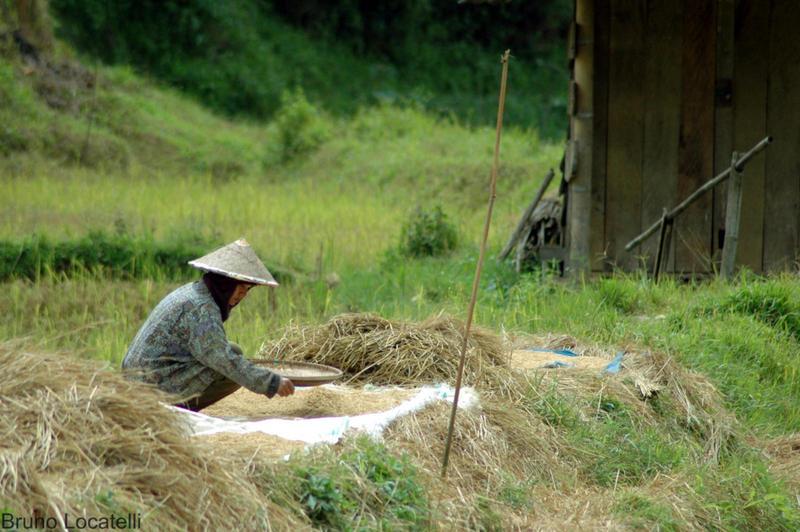Results & impact 10 October 2025
- Home
- Press area
- Press releases
- rise atmospheric CO2 impact crops
Climate change | Towards varieties that can adapt to a CO2-rich atmosphere

Atmospheric CO2 levels are currently running at 417 ppm, compared to 360 in 2000. The figure could top 600 ppm by 2050. The potential impact of such a change on crops is not yet clear © B. Locatelli, CIRAD
For some 800 000 years up to the Industrial Revolution, atmospheric CO2 levels fluctuated between 280 and 300 ppm. In 2000, the figure was 360 ppm. It is now estimated at 417 ppm, and the most optimistic forecasts for 2050 are between 600 and 700 ppm. Unless there is a genuine ecological transition, this trend will continue, and will necessarily have an impact on crops.
"A plant grows by means of photosynthesis, which allows it to convert carbon dioxide into carbohydrates", says CIRAD's Denis Fabre, an ecophysiologist who was one of the authors of the articles. "Any rapid increase in atmospheric CO2 will therefore substantially affect plant growth, yet very few studies have looked into this."
Plant carbon storage capacity is a major issue
Over the past four years, a team of researchers at CIRAD in Montpellier have been studying the reaction of rice varieties in greenhouses to high CO2 levels. Their initial work on several varieties has revealed varying capacities to adapt.
"We have observed that when CO2 increases, some varieties benefit from the change and produce more, while others stagnate" , Denis Fabre explains. "It is as if some plants had a sort of gastric band that prevented them storing extra food."
The researchers put this phenomenon down to the plants' capacity to store carbon, and their subsequent work has confirmed this.
"Plants have carbon storage capacities", Denis Fabre adds, "in other words the capacity to ex port sugar to growing organs or to storage sites, which results for instance in new tillers, or new shoots, on a stem. By testing plants with varying storage capacities, we observed that the greater the sink capacity of a plant, the more it benefitted from high atmospheric CO2 levels."
A major result for breeding operations, particularly for tree crops
Some plants can therefore adjust to increased CO2 levels by growing new stems to store sugar. Others cannot, and their yields stagnate.
"The rice and wheat varieties currently used were developed during the Green Revolution", Denis Fabre recalls. "Breeders worked to breed plants with shorter stems, since they are easier to harvest. However, those breeding operations were so intense that in our trials, the resulting varieties proved incapable of adapting to high CO2 levels."
By reducing the number of stems or shortening plants, varietal breeding considerably reduced the ability of the new varieties to store carbon. While those varieties are higher yielding than their predecessors, they will be unable to benefit from an atmosphere with more CO2.
"The aim is not to return to those ancient varieties, which are less productive, but to take account of this new variable: atmospheric carbon levels. It is crucial to steer breeding operations towards varieties capable of benefitting from the new higher levels", Delphine Luquet, another co-author of the articles, stresses. "This will go at least some way towards countering the negative effects of climate change on crops, notably environmental stress, which is increasingly common."
"For annual crops such as wheat and rice, breeding can begin again each year, so the stakes are lower. However, for tree crops, which involve using the same plants for 25 to 30 years, we need to start thinking now about the plants that will have to grow in a CO2-rich short-term future", Denis Fabre concludes.
AbioPhen, a greenhouse in Montpellier to simulate the future climate Controlled sunlight, humidity, temperature, atmospheric CO2, and so on… CIRAD Montpellier has six new 40-m2 glass compartments providing a facility that is the only one of its kind in France. The AbioPhen greenhouse gives scientists the opportunity to conduct precise analyses of the impact of climate change on plants. The facility has been fully operational for almost two years, and enables simulations that cannot be done in the field. The greenhouse was built with funding from a State-Region contract (€ 3M: € 2M from the Regional Council and € 1M from the State), as part of RéSEM (a network of experimental greenhouses in Montpellier). After a year's construction work in 2017, the new building was handed over in early 2018 and fully equipped by the start of 2019. |
References
Dingkuhn Michael, Luquet Delphine, Fabre Denis, Muller Bertrand, Yin Xinyou, Paul Matthew J. 2020. The case for improving crop carbon sink strength or plasticity for a CO2-rich future . Current Opinion in Plant Biology
Denis Fabre, Michael Dingkuhn, Xinyou Yin, Anne Clément‐Vidal, Sandrine Roques, Armelle Soutiras, Delphine Luquet. 2020. Genotypic variation in source and sink traits affects the response of photosynthesis and growth to elevated atmospheric CO2 . Plant, Cell & Environment
Denis Fabre, Xinyou Yin, Michael Dingkuhn, Anne Clément-Vidal, Sandrine Roques, Lauriane Rouan, Armelle Soutiras, Delphine Luquet. 2019. Is triose phosphate utilization involved in the feedback inhibition of photosynthesis in rice under conditions of sink limitation? Journal of Experimental Botany



























